Part II: Do’s and don’ts of tree planting
Published 12:48 pm Thursday, June 13, 2019
Last month, we talked about how to properly plant and care for trees. In this column, we will discuss planting considerations to maximize tree health and the many benefits they bring: absorbing stormwater runoff and filtering pollutants, creating wildlife habitat, and saving on home
energy costs. To enjoy these benefits to the fullest, consider several important factors before you begin planting. Determine how large the tree will be at full-growth stage and take this into consideration when placing the tree in your landscape. For example, if planting a large tree do not place it underneath overhead utilities, such as power lines, because the tree will grow into the lines at full-growth stage. Also consider the location of underground utilities, such as septic systems, which could be destroyed be tree roots and avoid those locations. Additionally, think about the soil conditions and sunlight requirements that the tree needs to thrive.
A common mistake is misjudging the water demand of a newly-planted tree. As we discussed last month, new trees have a high water demand. However, do not attempt to lessen the water demand of the leaves by pruning the crown or spraying the leaves with a desiccant (drying agent). Although these actions will lessen the water demand of the leaves, they will also decrease the energy available for the tree to make new roots. The tree depends on its leaves for the process of photosynthesis, which makes food and energy for the tree to carry out its functions, such as growing new roots. Pruning or drying out the leaves of a newly-planted tree will interfere with growth of new roots, which will worsen transplant shock. According to Jim McGlone of the Virginia Department of Forestry, “Improper pruning can also destroy the crown structure and cause the tree to become a hazard later in life.”
Trending
While under-watering or trying to lessen water demand can harm tree health, the opposite is also true; over-watering can be damaging too. Trees need oxygen and water, which are found in pore spaces in the soil. When the soil is water-logged as a result of over-watering, the water fills up all of the pore spaces in the soil and leaves no room for oxygen. Jim McGlone cautions that “[i]n the short-term, too much water prevents root growth and in the long term, it can kill the tree.”
Although it may be tempting to alter the soil that you put back in the planting hole, do not amend the backfill soil with compost or topsoil. Changing the soil immediately around the tree can cause hydrologic discontinuity — that is, the hydrologic properties of the soil that allow water to move in and out will be different from the hydrologic properties of the soil outside of the hole. This can make it difficult for water to enter or exit the planting hole. Also, do not fertilize the tree until after establishment. Adding fertilizer increases the nitrogen content, which causes new shoots to grow more rapidly from the leaves. This causes the leaves to be out of balance with the roots, which, as we discussed last month, can worsen transplant shock.
After you plant your new tree, apply a thin layer of mulch. According to Jim McGlone, “Mulch promotes beneficial microbial activity that increases water infiltration and reduces soil moisture evaporation. Trees grow five times more roots under mulch than under turf [grass].” However, do not over-apply mulch — 2 or 3 inches of mulch is enough. Adding too much mulch, especially in the form of “mulch volcanoes” around the trunk of the tree, causes water to flow away from the tree rather than toward the tree roots, which need water to survive. Avoid placing mulch in direct contact with the tree trunk or bark. Penn State Extension cautions that “trouble starts when the mulch is applied more heavily and in constant contact with a larger section of the tree’s trunk. When wet, the mulch holds too much moisture against the bark, which can cause it to start to break down. And as the mulch starts to compost it heats up, which can further damage the bark and the underlying vascular tissues, compromising the tree’s ability to transport water and nutrients. Too much mulch also blocks the roots from getting sufficient oxygen.”
As you plan your tree plantings, keep these tips in mind. Happy planting.
Emily Gibbs is the residential conservation and marketing coordinator at Piedmont Soil & Water Conservation. You can contact her at (434) 392-3782 ext. 131 or visit www.piedmontswcd.org.





